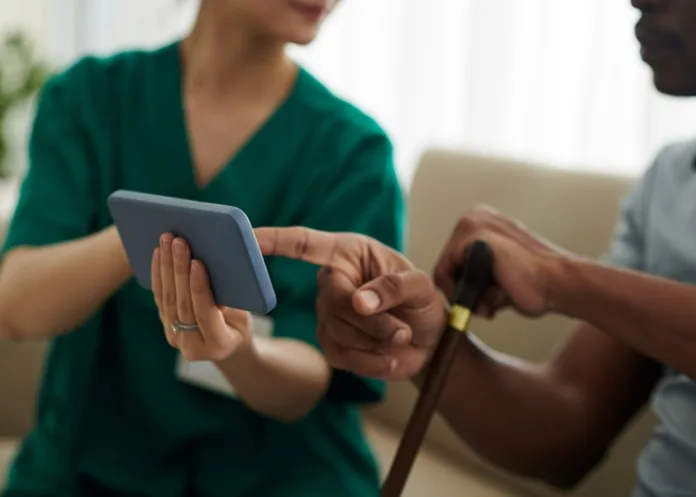In rural Kenya, 64-year-old John Kamau’s world of silence is about to change. After decades of being isolated by hearing loss from the community’s vibrant life and his grandchildren’s conversations, he sees hope when a community health worker visits with a smartphone in hand.
This visit is the gateway to Kamau’s reconnection with the world, facilitated by breakthrough digital health tools on a smartphone, writes De Wet Swanepoel in The Conversation.
A revolutionary hearing test app on the smartphone conducts precise assessments, followed by the provision of low-cost, high-quality hearing aids right there and then, and with these aids, programmed to his specific hearing profile via Bluetooth, Kamau can take part in ordinary conversations and hear his grandchildren laugh.
His is one of many lives being transformed through a high-tech, soft-touch approach: advanced digital technologies delivered through trained community members.
Africa’s silent epidemic
In Africa, an estimated 136m people have hearing loss, a figure expected to swell to 337m by 2050, with profound social and economic repercussions and contributing to an annual global cost of untreated hearing loss estimated at US$980bn.
The problem is exacerbated by a dire shortage of audiologists, with fewer than one for every million people on the continent, and the prohibitive costs of hearing aids for many in low- to middle-income countries.
Only 2% of those who need hearing aids in Africa wear them. There is also a widespread lack of awareness of the condition.
Revolutionising access to hearing care
I am a professor of audiology at the University of Pretoria where – working with the World Health Organisation and the hearX Foundation – we have developed digital devices being used to test hearing loss across the continent.
We are pioneering community-based hearing care initiatives in low-income communities in Kenya, as well as Khayelitsha, Gugulethu, Mbekweni, Atteridgeville and the Eastern Cape.
1.) A screening app for children
We have trained local community members to conduct hearing screenings in early childhood development centres, where nearly 50 000 children have been tested at a cost of less than US$6 per child.
Hearing loss is especially traumatic for children as it hampers language development and learning and leaves them at a disadvantage for life.
Community health workers need minimal training to carry out screenings with a simple screening app on an Android smartphone with calibrated headphones.
The app monitors noise in real time to make sure the surroundings are quiet enough for the test. Parents receive a text message with their child’s results and next steps if further interventions are needed. Community workers can also do eye tests on the same device in less than three minutes.
2.) Early child development training
We’ve launched a mobile health (mHealth) training programme focusing on ear and hearing ability for teachers in early childhood development centres.
Daily multimedia WhatsApp messages train teachers to identify hearing problems. Teachers are taught to assess if a child needs to move to the front of the class or to go for a hearing test.
The programme has already successfully trained thousands of teachers across South Africa.
3.) Screening adults
Our collaboration with the WHO has led to the creation of the hearWHO app, an official tool for screening adults. The app features an easy-to-use test that plays numbers with a background noise and asks users to press on these numbers.
Taking just two to three minutes to complete, the test has reached nearly 500m people in more than 190 countries since 2019.
The app displays user results and keeps a personalised track record of their hearing over time. It is available in English, Dutch, Mandarin, Russian and Spanish.
4.) Hearing aids for communities
In a recent feasibility study for the WHO, we explored the provision of hearing aids in low-income communities to inform the recently released WHO guidelines.
Community health workers, aided by an artificial intelligence system, analysed images of an eardrum. If the eardrum appeared normal – and a hearing loss was detected – he or she could be fitted immediately with hearing aids.
We have also partnered with the Clinton Health Access Initiative to expand our screening technology to eight countries in Africa and Asia.
As we continue to confront the challenges of hearing loss, the path forward is clear: integrating these innovative models into existing healthcare systems is imperative.
De Wet Swanepoel – Professor in Audiology in the Department of Speech-Language Pathology and Audiology, University of Pretoria
hearing problems tackled
See more from MedicalBrief archives:
Hearing aids linked to reduced risk of mental decline and falls but few get them
AAS's biennial prize for innovation goes to University of Pretoria audiologist
Bringing an African perspective to audiology

